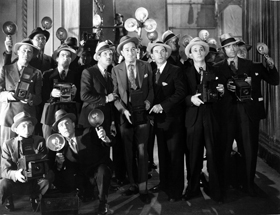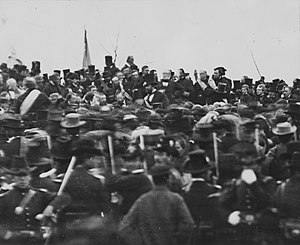![]()
This week’s
Outside the Box is unusual, even for a letter that is noted for its unusual offerings. It is a speech from last week by
Charles I. Plosser, President of the Federal Reserve Bank of Philadelphia at (surprisingly to me) the Cato Institute’s 31st Annual Monetary Conference, Washington, DC.
I suppose that if Dallas Fed President Richard Fisher had delivered this speech I would not be terribly surprised. I suspect there are some other Federal Reserve officials here and there who are in sympathy with this view Plosser presents here, but for quite some time no serious Fed official has outlined the need for a limited Federal Reserve in the way Plosser does today. He essentially proposes four limits on the US Federal Reserve:
- First, limit the Fed’s monetary policy goals to a narrow mandate in which price stability is the sole, or at least the primary, objective;
- Second, limit the types of assets that the Fed can hold on its balance sheet to Treasury securities;
- Third, limit the Fed’s discretion in monetary policymaking by requiring a systematic, rule-like approach;
- And fourth, limit the boundaries of its lender-of-last-resort credit extension.
“These steps would yield a more limited central bank. In doing so, they would help preserve the central bank’s independence, thereby improving the effectiveness of monetary policy, and they would make it easier for the public to hold the Fed accountable for its policy decisions.”
Some of you will want to read this deeply, but everyone should read the beginning and ending. I find this one of the most hopeful documents I have read in a long time. Think about the position of the person who delivered the speech. You are not alone in your desire to rein in the Fed.
Two points before we turn to the speech. Both Fisher and Plosser will be voting members of the FOMC this coming year. Look at the lineup and the philosophical monetary view of each of the members of the FOMC. Next year we could actually see three dissenting votes if things are not moving in a positive direction, although another serious proponent of monetary easing is being added to the Committee, so it may be that nothing will really change.

I am not seriously suggesting that the reigning economic theory that directs the action of the Fed is going to change anytime soon, but you will see assorted academics espousing a different viewpoint here and there. I think there may come a time in the not-too-distant future when the current Keynesian viewpoint is going to be somewhat discredited and people will be open to a new way to run things. This will not happen due to some great shift in philosophical views but because the current system has the potential to create some rather serious problems in the future. This is part of the message in my latest book, Code Red.
A lot of education and change in the system is needed. I want to applaud Alan Howard and his team at Brevan Howard for making one of the largest donations in business education history to Imperial College to establish the new Brevan Howard Centre for Financial Analysis to study exactly these topics and counter what is a particularly bad direction in academia. The two leaders at the new center, Professors Franklin Allen and Douglas Gale, are renowned for their pioneering research into financial crises and market contagion – that is, when relatively small shocks in financial institutions spread and grow, severely damaging the wider economy. This new center will help offer a better perspective. What we teach our kids matters. I hope other major fund managers will join this effort!
And speaking of Code Red, let me pass on a few quick reviews from Amazon:
“Excellent review of our current economic circumstances and what we can do about it to protect our assets. Even better, it is written with the non-economist in mind.”
“I read this book from cover to cover in 24 hours and was glued to every page. Do I know how to protect my saving exactly? No. But I have the critical information necessary to make informed decisions about my investments. My husband recommended this book to me after reading a brief article, and I’m so glad I impulsively bought it. It will definitely change my investment decisions moving forward and perhaps even provide me with more restful nights of sleep.”
You can order your own copy at the Mauldin Economics website or at Amazon, and it is likely at your local book store.
It is getting down to crunch time here in Dallas as far as the move to the new apartment is concerned. Work is coming along and most of it is done, although some things will need to be finished after I move in. Furniture is being delivered and moved in as I write, and today an the new kitchen is being entirely stocked, courtesy of Williams-Sonoma – they’ll be showing up in a few minutes. I am fulfilling a long-held dream (maybe even a fantasy or fetish) of throwing everything out of the kitchen and starting over from scratch. Between my kids and a returning missionary couple, all the old stuff will find a new home, and I will renew my role as chief chef with new relish next week.
I have always maintained that I think I am a pretty good writer but I a brilliant cook. With a new kitchen from top to bottom, I intend to spend more time developing my true talent. Between the new media room and my cooking, I hope I can persuade the kids (and their kids!) to come around more often. Yes, there are a few bumps and issues here and there, but in general life is going well. I just need to get into the gym more. Which we should all probably do!
Your feeling like a kid in a candy store analyst,
John Mauldin, Editor
Outside the Box[email protected]
A Limited Central Bank
Presented by Charles I. Plosser, President and Chief Executive Officer, Federal Reserve Bank of Philadelphia
Cato Institute’s 31st Annual Monetary Conference, Washington, D.C.
Highlights
- President Charles Plosser discusses what he believes is the Federal Reserve’s essential role and proposes how this institution might be improved to better fulfill that role.
- President Plosser proposes four limits on the central bank that would limit discretion and improve outcomes and accountability.
- First, limit the Fed’s monetary policy goals to a narrow mandate in which price stability is the sole, or at least the primary, objective;
- Second, limit the types of assets that the Fed can hold on its balance sheet to Treasury securities;
- Third, limit the Fed’s discretion in monetary policymaking by requiring a systematic, rule-like approach;
- And fourth, limit the boundaries of its lender-of-last-resort credit extension.
- These steps would yield a more limited central bank. In doing so, they would help preserve the central bank’s independence, thereby improving the effectiveness of monetary policy, and they would make it easier for the public to hold the Fed accountable for its policy decisions.
Introduction: The Importance of Institutions
I want to thank Jim Dorn and the Cato Institute for inviting me to speak once again at this prestigious Annual Monetary Conference. When Jim told me that this year’s conference was titled “Was the Fed a Good Idea?” I must confess that I was little worried. I couldn’t help but notice that I was the only sitting central banker on the program. But as the Fed approaches its 100th anniversary, it is entirely appropriate to reflect on its history and its future. Today, I plan to discuss what I believe is the Federal Reserve’s essential role and consider how it might be improved as an institution to better fulfill that role.
Before I begin, I should note that my views are not necessarily those of the Federal Reserve System or my colleagues on the Federal Open Market Committee (FOMC).
Douglass C. North was cowinner of the 1993 Nobel Prize in Economics for his work on the role that institutions play in economic growth.1 North argued that institutions were deliberately devised to constrain interactions among parties both public and private. In the spirit of North’s work, one theme of my talk today will be that the institutional structure of the central bank matters. The central bank’s goals and objectives, its framework for implementing policy, and its governance structure all affect its performance.
Central banks have been around for a long time, but they have clearly evolved as economies and governments have changed. Most countries today operate under a fiat money regime, in which a nation’s currency has value because the government says it does. Central banks usually are given the responsibility to protect and preserve the value or purchasing power of the currency.2 In the U.S., the Fed does so by buying or selling assets in order to manage the growth of money and credit. The ability to buy and sell assets gives the Fed considerable power to intervene in financial markets not only through the quantity of its transactions but also through the types of assets it can buy and sell. Thus, it is entirely appropriate that governments establish their central banks with limits that constrain the actions of the central bank to one degree or another.
Yet, in recent years, we have seen many of the explicit and implicit limits stretched. The Fed and many other central banks have taken extraordinary steps to address a global financial crisis and the ensuing recession. These steps have challenged the accepted boundaries of central banking and have been both applauded and denounced. For example, the Fed has adopted unconventional large-scale asset purchases to increase accommodation after it reduced its conventional policy tool, the federal funds rate, to near zero. These asset purchases have led to the creation of trillions of dollars of reserves in the banking system and have greatly expanded the Fed’s balance sheet. But the Fed has done more than just purchase lots of assets; it has altered the composition of its balance sheet through the types of assets it has purchased. I have spoken on a number of occasions about my concerns that these actions to purchase specific (non-Treasury) assets amounted to a form of credit allocation, which targets specific industries, sectors, or firms. These credit policies cross the boundary from monetary policy and venture into the realm of fiscal policy.3 I include in this category the purchases of mortgage-backed securities (MBS) as well as emergency lending under Section 13(3) of the Federal Reserve Act, in support of the bailouts, most notably of Bear Stearns and AIG. Regardless of the rationale for these actions, one needs to consider the long-term repercussions that such actions may have on the central bank as an institution.
As we contemplate what the Fed of the future should look like, I will discuss whether constraints on its goals might help limit the range of objectives it could use to justify its actions. I will also consider restrictions on the types of assets it can purchase to limit its interference with market allocations of scarce capital and generally to avoid engaging in actions that are best left to the fiscal authorities or the markets. I will also touch on governance and accountability of our institution and ways to implement policies that limit discretion and improve outcomes and accountability.
Goals and Objectives
Let me begin by addressing the goals and objectives for the Federal Reserve. These have evolved over time. When the Fed was first established in 1913, the U.S. and the world were operating under a classical gold standard. Therefore, price stability was not among the stated goals in the original Federal Reserve Act. Indeed, the primary objective in the preamble was to provide an “elastic currency.”
The gold standard had some desirable features. Domestic and international legal commitments regarding convertibility were important disciplining devices that were essential to the regime’s ability to deliver general price stability. The gold standard was a de facto rule that most people understood, and it allowed markets to function more efficiently because the price level was mostly stable.
But, the international gold standard began to unravel and was abandoned during World War I.4 After the war, efforts to reestablish parity proved disruptive and costly in both economic and political terms. Attempts to reestablish a gold standard ultimately fell apart in the 1930s. As a result, most of the world now operates under a fiat money regime, which has made price stability an important priority for those central banks charged with ensuring the purchasing power of the currency.
Congress established the current set of monetary policy goals in 1978. The amended Federal Reserve Act specifies the Fed “shall maintain long run growth of the monetary and credit aggregates commensurate with the economy’s long run potential to increase production, so as to promote effectively the goals of maximum employment, stable prices, and moderate long-term interest rates.” Since moderate long-term interest rates generally result when prices are stable and the economy is operating at full employment, many have interpreted these goals as a dual mandate with price stability and maximum employment as the focus.
Let me point out that the instructions from Congress call for the FOMC to stress the “long run growth” of money and credit commensurate with the economy’s “long run potential.” There are many other things that Congress could have specified, but it chose not to do so. The act doesn’t talk about managing short-term credit allocation across sectors; it doesn’t mention inflating housing prices or other asset prices. It also doesn’t mention reducing short-term fluctuations in employment.
Many discussions about the Fed’s mandate seem to forget the emphasis on the long run. The public, and perhaps even some within the Fed, have come to accept as an axiom that monetary policy can and should attempt to manage fluctuations in employment. Rather than simply set a monetary environment “commensurate” with the “long run potential to increase production,” these individuals seek policies that attempt to manage fluctuations in employment over the short run.
The active pursuit of employment objectives has been and continues to be problematic for the Fed. Most economists are dubious of the ability of monetary policy to predictably and precisely control employment in the short run, and there is a strong consensus that, in the long run, monetary policy cannot determine employment. As the FOMC noted in its statement on longer-run goals adopted in 2012, “the maximum level of employment is largely determined by nonmonetary factors that affect the structure and dynamics of the labor market.” In my view, focusing on short-run control of employment weakens the credibility and effectiveness of the Fed in achieving its price stability objective. We learned this lesson most dramatically during the 1970s when, despite the extensive efforts to reduce unemployment, the Fed essentially failed, and the nation experienced a prolonged period of high unemployment and high inflation. The economy paid the price in the form of a deep recession, as the Fed sought to restore the credibility of its commitment to price stability.
When establishing the longer-term goals and objectives for any organization, and particularly one that serves the public, it is important that the goals be achievable. Assigning unachievable goals to organizations is a recipe for failure. For the Fed, it could mean a loss of public confidence. I fear that the public has come to expect too much from its central bank and too much from monetary policy, in particular. We need to heed the words of another Nobel Prize winner, Milton Friedman. In his 1967 presidential address to the American Economic Association, he said, “…we are in danger of assigning to monetary policy a larger role than it can perform, in danger of asking it to accomplish tasks that it cannot achieve, and as a result, in danger of preventing it from making the contribution that it is capable of making.”5 In the 1970s we saw the truth in Friedman’s earlier admonitions. I think that over the past 40 years, with the exception of the Paul Volcker era, we failed to heed this warning. We have assigned an ever-expanding role for monetary policy, and we expect our central bank to solve all manner of economic woes for which it is ill-suited to address. We need to better align the expectations of monetary policy with what it is actually capable of achieving.
The so-called dual mandate has contributed to this expansionary view of the powers of monetary policy. Even though the 2012 statement of objectives acknowledged that it is inappropriate to set a fixed goal for employment and that maximum employment is influenced by many factors, the FOMC’s recent policy statements have increasingly given the impression that it wants to achieve an employment goal as quickly as possible.6
I believe that the aggressive pursuit of broad and expansive objectives is quite risky and could have very undesirable repercussions down the road, including undermining the public’s confidence in the institution, its legitimacy, and its independence. To put this in different terms, assigning multiple objectives for the central bank opens the door to highly discretionary policies, which can be justified by shifting the focus or rationale for action from goal to goal.
I have concluded that it would be appropriate to redefine the Fed’s monetary policy goals to focus solely, or at least primarily, on price stability. I base this on two facts: Monetary policy has very limited ability to influence real variables, such as employment. And, in a regime with fiat currency, only the central bank can ensure price stability. Indeed, it is the one goal that the central bank can achieve over the longer run.
Governance and Central Bank Independence
Even with a narrow mandate to focus on price stability, the institution must be well designed if it is to be successful. To meet even this narrow mandate, the central bank must have a fair amount of independence from the political process so that it can set policy for the long run without the pressure to print money as a substitute for tough fiscal choices. Good governance requires a healthy degree of separation between those responsible for taxes and expenditures and those responsible for printing money.
The original design of the Fed’s governance recognized the importance of this independence. Consider its decentralized, public-private structure, with Governors appointed by the U.S. President and confirmed by the Senate, and Fed presidents chosen by their boards of directors. This design helps ensure a diversity of views and a more decentralized governance structure that reduces the potential for abuses and capture by special interests or political agendas. It also reinforces the independence of monetary policymaking, which leads to better economic outcomes.
Implementing Policy and Limiting Discretion
Such independence in a democracy also necessitates that the central bank remain accountable. Its activities also need to be constrained in a manner that limits its discretionary authority. As I have already argued, a narrow mandate is an important limiting factor on an expansionist view of the role and scope for monetary policy.
What other sorts of constraints are appropriate on the activities of central banks? I believe that monetary policy and fiscal policy should have clear boundaries.7 Independence is what Congress can and should grant the Fed, but, in exchange for such independence, the central bank should be constrained from conducting fiscal policy. As I have already mentioned, the Fed has ventured into the realm of fiscal policy by its purchase programs of assets that target specific industries and individual firms. One way to circumscribe the range of activities a central bank can undertake is to limit the assets it can buy and hold.
In its System Open Market Account, the Fed is allowed to hold only U.S. government securities and securities that are direct obligations of or fully guaranteed by agencies of the United States. But these restrictions still allowed the Fed to purchase large amounts of agency mortgage-backed securities in its effort to boost the housing sector. My preference would be to limit Fed purchases to Treasury securities and return the Fed’s balance sheet to an all-Treasury portfolio. This would limit the ability of the Fed to engage in credit policies that target specific industries. As I’ve already noted, such programs to allocate credit rightfully belong in the realm of the fiscal authorities — not the central bank.
A third way to constrain central bank actions is to direct the monetary authority to conduct policy in a systematic, rule-like manner.8 It is often difficult for policymakers to choose a systematic rule-like approach that would tie their hands and thus limit their discretionary authority. Yet, research has discussed the benefits of rule-like behavior for some time. Rules are transparent and therefore allow for simpler and more effective communication of policy decisions. Moreover, a large body of research emphasizes the important role expectations play in determining economic outcomes. When policy is set systematically, the public and financial market participants can form better expectations about policy. Policy is no longer a source of instability or uncertainty. While choosing an appropriate rule is important, research shows that in a wide variety of models simple, robust monetary policy rules can produce outcomes close to those delivered by each model’s optimal policy rule.
Systematic policy can also help preserve a central bank’s independence. When the public has a better understanding of policymakers’ intentions, it is able to hold the central bank more accountable for its actions. And the rule-like behavior helps to keep policy focused on the central bank’s objectives, limiting discretionary actions that may wander toward other agendas and goals.
Congress is not the appropriate body to determine the form of such a rule. However, Congress could direct the monetary authority to communicate the broad guidelines the authority will use to conduct policy. One way this might work is to require the Fed to publicly describe how it will systematically conduct policy in normal times — this might be incorporated into the semiannual Monetary Policy Report submitted to Congress. This would hold the Fed accountable. If the FOMC chooses to deviate from the guidelines, it must then explain why and how it intends to return to its prescribed guidelines.
My sense is that the recent difficulty the Fed has faced in trying to offer clear and transparent guidance on its current and future policy path stems from the fact that policymakers still desire to maintain discretion in setting monetary policy. Effective forward guidance, however, requires commitment to behave in a particular way in the future. But discretion is the antithesis of commitment and undermines the effectiveness of forward guidance. Given this tension, few should be surprised that the Fed has struggled with its communications.
What is the answer? I see three: Simplify the goals. Constrain the tools. Make decisions more systematically. All three steps can lead to clearer communications and a better understanding on the part of the public. Creating a stronger policymaking framework will ultimately produce better economic outcomes.
Financial Stability and Monetary Policy
Before concluding, I would like to say a few words about the role that the central bank plays in promoting financial stability. Since the financial crisis, there has been an expansion of the Fed’s responsibilities for controlling macroprudential and systemic risk. Some have even called for an expansion of the monetary policy mandate to include an explicit goal for financial stability. I think this would be a mistake.
The Fed plays an important role as the lender of last resort, offering liquidity to solvent firms in times of extreme financial stress to forestall contagion and mitigate systemic risk. This liquidity is intended to help ensure that solvent institutions facing temporary liquidity problems remain solvent and that there is sufficient liquidity in the banking system to meet the demand for currency. In this sense, liquidity lending is simply providing an “elastic currency.”
Thus, the role of lender of last resort is not to prop up insolvent institutions. However, in some cases during the crisis, the Fed played a role in the resolution of particular insolvent firms that were deemed systemically important financial firms. Subsequently, the Dodd-Frank Act has limited some of the lending actions the Fed can take with individual firms under Section 13(3). Nonetheless, by taking these actions, the Fed has created expectations — perhaps unrealistic ones — about what the Fed can and should do to combat financial instability.
Just as it is true for monetary policy, it is important to be clear about the Fed’s responsibilities for promoting financial stability. It is unrealistic to expect the central bank to alleviate all systemic risk in financial markets. Expanding the Fed’s regulatory responsibilities too broadly increases the chances that there will be short-run conflicts between its monetary policy goals and its supervisory and regulatory goals. This should be avoided, as it could undermine the credibility of the Fed’s commitment to price stability.
Similarly, the central bank should set boundaries and guidelines for its lending policy that it can credibly commit to follow. If the set of institutions having regular access to the Fed’s credit facilities is expanded too far, it will create moral hazard and distort the market mechanism for allocating credit. This can end up undermining the very financial stability that it is supposed to promote.
Emergencies can and do arise. If the Fed is asked by the fiscal authorities to intervene by allocating credit to particular firms or sectors of the economy, then the Treasury should take these assets off of the Fed’s balance sheet in exchange for Treasury securities. In 2009, I advocated that we establish a new accord between the Treasury and the Federal Reserve that protects the Fed in just such a way.9 Such an arrangement would be similar to the Treasury-Fed Accord of 1951 that freed the Fed from keeping the interest rate on long-term Treasury debt below 2.5 percent. It would help ensure that when credit policies put taxpayer funds at risk, they are the responsibility of the fiscal authority — not the Fed. A new accord would also return control of the Fed’s balance sheet to the Fed so that it can conduct independent monetary policy.
Many observers think financial instability is endemic to the financial industry, and therefore, it must be controlled through regulation and oversight. However, financial instability can also be a consequence of governments and their policies, even those intended to reduce instability. I can think of three ways in which central bank policies can increase the risks of financial instability. First, by rescuing firms or creating the expectation that creditors will be rescued, policymakers either implicitly or explicitly create moral hazard and excessive risking-taking by financial firms. For this moral hazard to exist, it doesn’t matter if the taxpayer or the private sector provides the funds. What matters is that creditors are protected, in part, if not entirely.
Second, by running credit policies, such as buying huge volumes of mortgage-backed securities that distort market signals or the allocation of capital, policymakers can sow the seeds of financial instability because of the distortions that they create, which in time must be corrected.
And third, by taking a highly discretionary approach to monetary policy, policymakers increase the risks of financial instability by making monetary policy uncertain. Such uncertainty can lead markets to make unwise investment decisions — witness the complaints of those who took positions expecting the Fed to follow through with the taper decision in September of this year.
The Fed and other policymakers need to think more about the way their policies might contribute to financial instability. I believe that it is important that the Fed take steps to conduct its own policies and to help other regulators reduce the contributions of such policies to financial instability. The more limited role for the central bank I have described here can contribute to such efforts.
Conclusion
The financial crisis and its aftermath have been challenging times for global economies and their institutions. The extraordinary actions taken by the Fed to combat the crisis and the ensuing recession and to support recovery have expanded the roles assigned to monetary policy. The public has come to expect too much from its central bank. To remedy this situation, I believe it would be appropriate to set four limits on the central bank:
- First, limit the Fed’s monetary policy goals to a narrow mandate in which price stability is the sole, or at least the primary, objective;
- Second, limit the types of assets that the Fed can hold on its balance sheet to Treasury securities;
- Third, limit the Fed’s discretion in monetary policymaking by requiring a systematic, rule-like approach;
- And fourth, limit the boundaries of its lender-of-last-resort credit extension and ensure that it is conducted in a systematic fashion
- These steps would yield a more limited central bank. In doing so, they would help preserve the central bank’s independence, thereby improving the effectiveness of monetary policy, and, at the same time, they would make it easier for the public to hold the Fed accountable for its policy decisions. These changes to the institution would strengthen the Fed for its next 100 years.
* The views expressed are my own and not necessarily those of the Federal Reserve System or the FOMC.
1 For more about Douglass C. North and his cowinner Robert W. Fogel and the 1993 Nobel Memorial Prize in Economic Sciences, see Nobel Media, “The Prize in Economics 1993 – Press Release,” (1993), www.nobelprize.org/nobel_prizes/economic-sciences/laureates/1993/press.html (Accessed November 11, 2013). See also Douglass C. North, “Institutions,” Journal of Economic Perspectives, 5:1 (1991), pp. 97-112.
2 Countries can and do pursue different means of setting the value of their currency, including pegging their monetary policy to that of another country, but I will not concern myself with such issues in these comments.
3 See Charles Plosser, “Ensuring Sound Monetary Policy in the Aftermath of Crisis,” speech given to the U.S. Monetary Policy Forum, The Initiative on Global Markets, University of Chicago Booth School of Business, New York, NY, February 27, 2009, and Charles Plosser, “Fiscal Policy and Monetary Policy: Restoring the Boundaries,” a speech to the same group, February 24, 2012.
4 See Ben S. Bernanke, “A Century of U.S. Central Banking: Goals, Frameworks, Accountability,” speech to the National Bureau of Economic Research, Cambridge, MA, July 10, 2013; and Jeffrey M. Lacker, “Global Interdependence and Central Banking,” speech to the Global Interdependence Center, Philadelphia, November 1, 2013.
5 See Milton Friedman, “The Role of Monetary Policy,” American Economic Review, 58:1 (March 1968), pp. 1-17.
6 See Daniel L. Thornton, “The Dual Mandate: Has the Fed Changed Its Objective?” Federal Reserve Bank of St. Louis Review, 94 (March/April 2012), pp. 117-33.
7 See Plosser (2009) and Plosser (2012).
8 See Charles Plosser, “The Benefits of Systematic Monetary Policy,” speech given to the National Association for Business Economics, Washington Economic Policy Conference, Washington, D.C., March 3, 2008. Also see Finn E. Kydland and Edward C. Prescott, “Rules Rather Than Discretion: The Inconsistency of Optimal Plans,” Journal of Political Economy, 85 (January 1977), pp. 473-91.
9 See Plosser (2009).
Like Outside the Box?
Sign up today and get each new issue delivered free to your inbox.
It’s your opportunity to get the news John Mauldin thinks matters most to your finances.
© 2013 Mauldin Economics. All Rights Reserved.
Outside the Box is a free weekly economic e-letter by best-selling author and renowned financial expert, John Mauldin. You can learn more and get your free subscription by visiting www.MauldinEconomics.com.
Please write to [email protected] to inform us of any reproductions, including when and where copy will be reproduced. You must keep the letter intact, from introduction to disclaimers. If you would like to quote brief portions only, please reference www.MauldinEconomics.com.
To subscribe to John Mauldin’s e-letter, please click here: http://www.mauldineconomics.com/subscribe
To change your email address, please click here: http://www.mauldineconomics.com/change-address
Outside the Box and MauldinEconomics.com is not an offering for any investment. It represents only the opinions of John Mauldin and those that he interviews. Any views expressed are provided for information purposes only and should not be construed in any way as an offer, an endorsement, or inducement to invest and is not in any way a testimony of, or associated with, Mauldin’s other firms. John Mauldin is the Chairman of Mauldin Economics, LLC. He also is the President of Millennium Wave Advisors, LLC (MWA) which is an investment advisory firm registered with multiple states, President and registered representative of Millennium Wave Securities, LLC, (MWS) member FINRA, SIPC, through which securities may be offered . MWS is also a Commodity Pool Operator (CPO) and a Commodity Trading Advisor (CTA) registered with the CFTC, as well as an Introducing Broker (IB) and NFA Member. Millennium Wave Investments is a dba of MWA LLC and MWS LLC. This message may contain information that is confidential or privileged and is intended only for the individual or entity named above and does not constitute an offer for or advice about any alternative investment product. Such advice can only be made when accompanied by a prospectus or similar offering document. Past performance is not indicative of future performance. Please make sure to review important disclosures at the end of each article. Mauldin companies may have a marketing relationship with products and services mentioned in this letter for a fee.
Note: Joining The Mauldin Circle is not an offering for any investment. It represents only the opinions of John Mauldin and Millennium Wave Investments. It is intended solely for investors who have registered with Millennium Wave Investments and its partners at http://www.MauldinCircle.com (formerly AccreditedInvestor.ws) or directly related websites. The Mauldin Circle may send out material that is provided on a confidential basis, and subscribers to the Mauldin Circle are not to send this letter to anyone other than their professional investment counselors. Investors should discuss any investment with their personal investment counsel. You are advised to discuss with your financial advisers your investment options and whether any investment is suitable for your specific needs prior to making any investments. John Mauldin is the President of Millennium Wave Advisors, LLC (MWA), which is an investment advisory firm registered with multiple states. John Mauldin is a registered representative of Millennium Wave Securities, LLC, (MWS), an FINRA registered broker-dealer. MWS is also a Commodity Pool Operator (CPO) and a Commodity Trading Advisor (CTA) registered with the CFTC, as well as an Introducing Broker (IB). Millennium Wave Investments is a dba of MWA LLC and MWS LLC. Millennium Wave Investments cooperates in the consulting on and marketing of private and non-private investment offerings with other independent firms such as Altegris Investments; Capital Management Group; Absolute Return Partners, LLP; Fynn Capital; Nicola Wealth Management; and Plexus Asset Management. Investment offerings recommended by Mauldin may pay a portion of their fees to these independent firms, who will share 1/3 of those fees with MWS and thus with Mauldin. Any views expressed herein are provided for information purposes only and should not be construed in any way as an offer, an endorsement, or inducement to invest with any CTA, fund, or program mentioned here or elsewhere. Before seeking any advisor’s services or making an investment in a fund, investors must read and examine thoroughly the respective disclosure document or offering memorandum. Since these firms and Mauldin receive fees from the funds they recommend/market, they only recommend/market products with which they have been able to negotiate fee arrangements.
PAST RESULTS ARE NOT INDICATIVE OF FUTURE RESULTS. THERE IS RISK OF LOSS AS WELL AS THE OPPORTUNITY FOR GAIN WHEN INVESTING IN MANAGED FUNDS. WHEN CONSIDERING ALTERNATIVE INVESTMENTS, INCLUDING HEDGE FUNDS, YOU SHOULD CONSIDER VARIOUS RISKS INCLUDING THE FACT THAT SOME PRODUCTS: OFTEN ENGAGE IN LEVERAGING AND OTHER SPECULATIVE INVESTMENT PRACTICES THAT MAY INCREASE THE RISK OF INVESTMENT LOSS, CAN BE ILLIQUID, ARE NOT REQUIRED TO PROVIDE PERIODIC PRICING OR VALUATION INFORMATION TO INVESTORS, MAY INVOLVE COMPLEX TAX STRUCTURES AND DELAYS IN DISTRIBUTING IMPORTANT TAX INFORMATION, ARE NOT SUBJECT TO THE SAME REGULATORY REQUIREMENTS AS MUTUAL FUNDS, OFTEN CHARGE HIGH FEES, AND IN MANY CASES THE UNDERLYING INVESTMENTS ARE NOT TRANSPARENT AND ARE KNOWN ONLY TO THE INVESTMENT MANAGER. Alternative investment performance can be volatile. An investor could lose all or a substantial amount of his or her investment. Often, alternative investment fund and account managers have total trading authority over their funds or accounts; the use of a single advisor applying generally similar trading programs could mean lack of diversification and, consequently, higher risk. There is often no secondary market for an investor’s interest in alternative investments, and none is expected to develop.

























